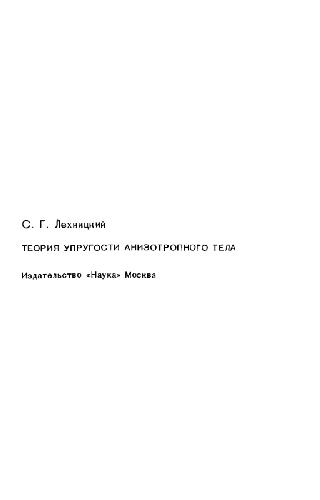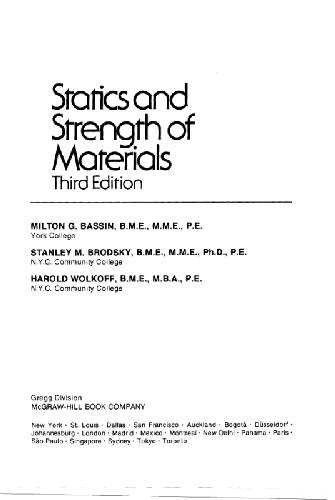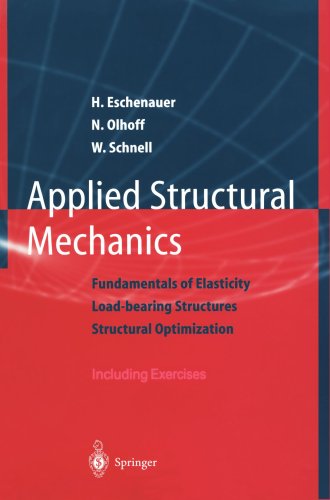Apel N.3-937859-00-4
Table of contents :
Introduction……Page 15
Representation, Transformation and Rotation of Tensorial Objects……Page 21
Motion of a Body……Page 25
Stresses……Page 28
Heat Flux……Page 29
Balance of Linear Momentum……Page 30
Balance of Total Energy……Page 31
Constitutive Equations……Page 33
Material Symmetry……Page 34
Construction of a Space Lattice……Page 37
Rotations……Page 38
Tensor Representations……Page 39
Triclinic Symmetry……Page 40
Orthorhombic Symmetry……Page 41
Tetragonal Symmetry……Page 42
Trigonal and Hexagonal Symmetry……Page 43
Summary……Page 44
Icosahedral, Cylindrical and Spherical Symmetry Classes……Page 46
Classification into 14 Types of Anisotropy……Page 49
Definitions and Notions……Page 51
Isotropic Extension of Anisotropic Tensor Functions……Page 52
Wang’s Approach……Page 53
Smith’s Approach……Page 56
Definitions……Page 60
Integrity Basis for Sets of First-Order Tensors……Page 61
Isotropic Tensors……Page 62
Integrity Bases for Sets of First-Order and Second-Order Tensors……Page 63
Irreducibility of Integrity Bases and Functional Bases……Page 65
Quadratic Functions of a Symmetric Second-Order Tensor……Page 66
Triclinic Functions — Symmetry Group Ci……Page 67
Monoclinic Functions — Symmetry Group C2h……Page 69
Orthorhombic Functions — Symmetry Group D2h……Page 71
Tetragonal Functions — Symmetry Group C4h……Page 72
Tetragonal Functions — Symmetry Group D4h……Page 74
Trigonal Functions — Symmetry Group S6……Page 75
Trigonal Functions — Symmetry Group D3d……Page 77
Hexagonal Functions — Symmetry Group C6h……Page 79
Hexagonal Functions — Symmetry Group D6h……Page 80
Cubic Functions — Symmetry Group Oh……Page 82
Cubic Functions — Symmetry Group Th……Page 83
Transversely Isotropic Functions — Symmetry Group Ch……Page 84
Transversely Isotropic Functions — Symmetry Group Dh……Page 85
Conclusion……Page 87
General Framework……Page 89
Fiber-Reinforced Technical Rubber……Page 90
Numerical Example: Tension Test of a Fiber-Reinforced Bar……Page 91
Numerical Example: Inflation of a Fiber-Reinforced Sheet……Page 93
Geometry of Multiplicative Plasticity, Stress Tensors……Page 95
Energy Storage and Elastic Stress Response……Page 96
Dissipation and Plastic Flow Response……Page 97
Decoupling of the Constitutive Functions……Page 98
Continuous Tangent Moduli……Page 99
Outline of the Standard Stress Update Algorithms……Page 100
Implicit Stress Update Algorithm (U1)……Page 102
Explicit Stress Update Algorithm (U2)……Page 104
Algorithmic Tangent Moduli……Page 106
Variational Formulation……Page 108
Standard Formulation of Rate-Independent Plasticity……Page 109
Incremental Variational Formulation……Page 110
Specification to Multi-Surface Plasticity……Page 111
Implicit Discrete Variational Formulation (V1)……Page 113
Algorithmic Solution of the Discrete Variational Formulation (V1)……Page 115
Application of the Algorithm (V1) to the Model Problem……Page 116
Algorithmic Solution of the Discrete Variational Formulation (V2)……Page 118
Stresses and Algorithmic Tangent Moduli (V2)……Page 119
Model Problem: Double Slip Plasticity……Page 121
Numerical Example: Rotation of the Slip Systems……Page 122
Numerical Example: Drawing of a Flange……Page 124
Plastic Response……Page 125
D2h-, Oh-, Dh and O(3)-invariant Fourth-Order Tensors……Page 126
Comparison of the Stress Update Algorithms……Page 128
Kelvin-Mode Decomposition of Fourth-Order Tensors……Page 130
Energy Storage and Elastic Stress Response……Page 131
Decoupling of the Constitutive Functions……Page 132
Implicit Stress Update Algorithm……Page 133
Algorithmic Tangent Moduli……Page 134
Current Metric, Plastic Metric and Stresses……Page 137
Energy Storage and Elastic Stress Response……Page 139
Dissipation and Plastic Flow Response……Page 140
Considered Model Problem……Page 141
Continuous Elastic-Plastic Tangent Moduli……Page 142
Stress Update Algorithm……Page 143
Variational Formulation in the Logarithmic Strain Space……Page 146
Incremental Variational Formulation……Page 147
Specification to Multi-Surface Models of Elasto-Plasticity……Page 148
Algorithmic Solution……Page 149
Stresses and Moduli……Page 150
Application to Model Problem……Page 152
Parameterization of the Shell-Like Continuum……Page 153
Compatible Displacement Approach……Page 154
Assumed Strain Modifications……Page 155
Enhanced Strain Modifications……Page 156
Variational Formulation……Page 157
Gradient-type Interface to Constitutive Models……Page 159
Necking of an Isotropic Rod……Page 161
Necking of an Isotropic Rectangular Strip……Page 163
Drawing of a Circular Flange……Page 167
Comparison of Additive and Multiplicative Plasticity……Page 168
Comparison of the Stress Update Algorithms……Page 170
Deep Drawing of Cubic and Orthotropic Sheets……Page 174
Comparison of Additive and Multiplicative Plasticity……Page 175
Comparison of Multiplicative and Additive Shell Element Design……Page 178
Summary and Conclusion……Page 181
References……Page 183
Coordinate Representation……Page 193
Spectral Decomposition of Symmetric Fourth-Order Tensors……Page 194
Incremental Variational Formulation — Derivatives……Page 195
Positively Homogenous Functions of Degree One……Page 196







Reviews
There are no reviews yet.